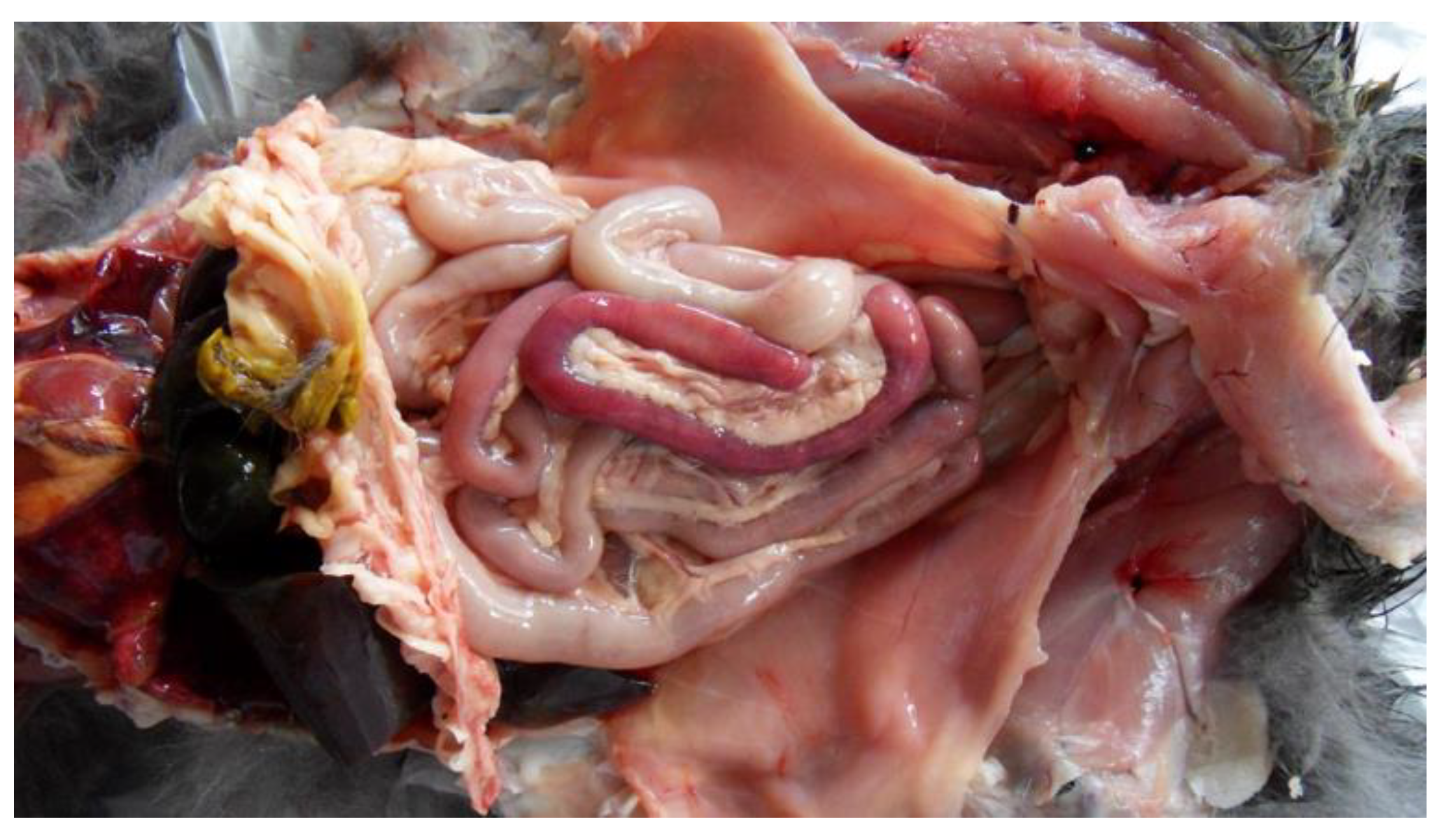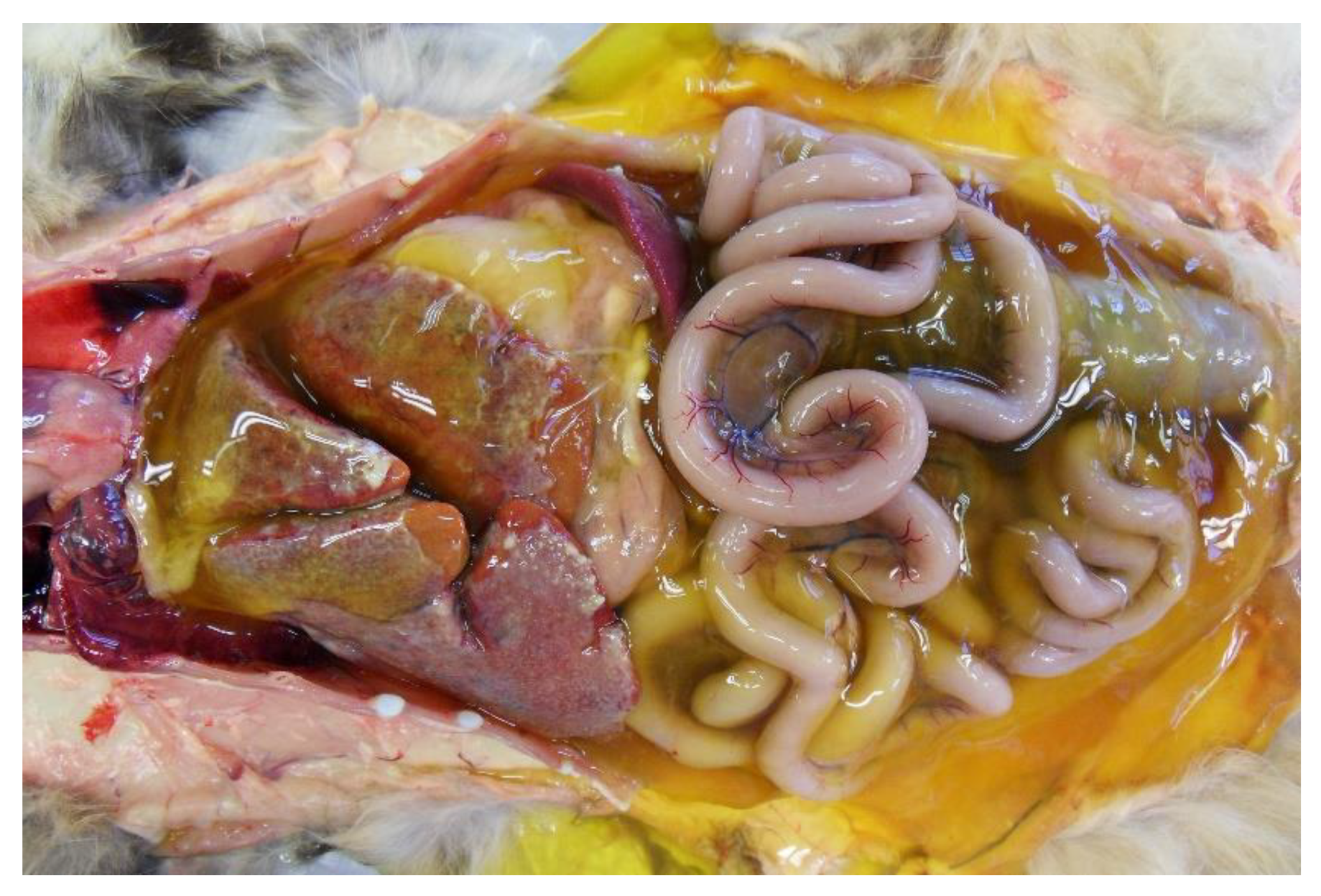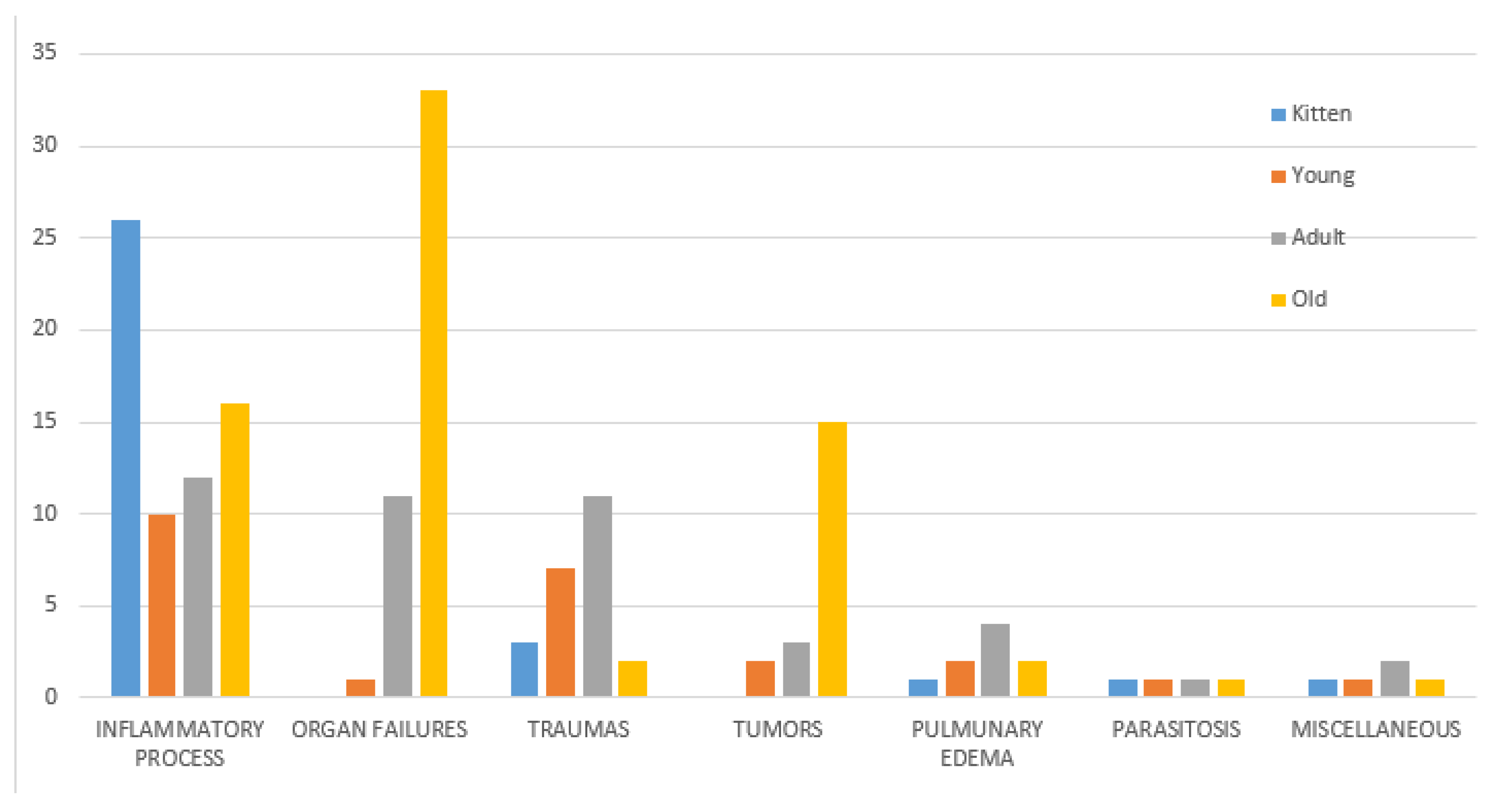Causes of Death in Stray Cat Colonies of Milan: A Five-Year Report
Abstract
:Simple Summary
Abstract
1. Introduction
2. Materials and Methods
2.1. Animals
2.2. Statistical Analysis
3. Results
3.1. Cats
3.2. Colonies
3.3. Breeds and Sex
3.4. Age
3.5. Body Condition
3.6. Causes of Death
3.7. Statistical Analysis
4. Discussion
5. Conclusions
Supplementary Materials
Author Contributions
Funding
Institutional Review Board Statement
Conflicts of Interest
References
- Levy, J.K.; Gale, D.W.; Gale, L.A. Evaluation of the effect of a long-term trap-neuter-return and adoption program on a free-roaming cat population. J. Am. Vet. Med. Assoc. 2003, 222, 42–46. [Google Scholar] [CrossRef] [PubMed] [Green Version]
- Robertson, S.A. A review of feral cat control. J. Feline Med. Surg. 2007, 10, 366–375. [Google Scholar] [CrossRef] [PubMed]
- Vigne, J.D.; Guilaine, J.; Debue, K.; Haye, L.; Gérard, P. Early taming of the cat in Cyprus. Science 2004, 304, 259. [Google Scholar] [CrossRef] [PubMed] [Green Version]
- Driscoll, C.A.; Menotti-Raymond, M.; Roca, A.L.; Hupe, K.; Johnson, W.E.; Geffen, E.; Harley, E.H.; Delibes, M.; Pontier, D.; Kitchener, A.C.; et al. The Near Eastern origin of cat domestication. Science 2007, 317, 519–523. [Google Scholar] [CrossRef] [Green Version]
- Natoli, E. Urban feral cats (Felis catus L.): Perspectives for a demographic control respecting the psycho-biological welfare of the species. Ann. Ist. Super. Sanita 1994, 30, 223–227. [Google Scholar] [PubMed]
- Jessup, D.A. The welfare of feral cats and wildlife. J. Am. Vet. Med. Assoc. 2004, 225, 1377–1383. [Google Scholar] [CrossRef] [Green Version]
- McCarthy, R.J.; Levine, S.H.; Reed, J.M. Estimation of effectiveness of three methods of feral cat population control by use of a simulation model. J. Am. Vet. Med. Assoc. 2013, 243, 502–511. [Google Scholar] [CrossRef] [PubMed]
- Castillo, D.; Clarke, A.L. Trap/neuter/release methods ineffective in controlling domestic cat “colonies” on public lands. Nat. Area J. 2003, 23, 247–253. [Google Scholar]
- Slater, M.R. The welfare of feral cats. In The Welfare of Cats; Rochlitz, I., Ed.; Springer: Berlin/Heidelberg, Germany, 2005; pp. 141–176. [Google Scholar] [CrossRef]
- Natoli, E.; De Vito, E. Agonistic behaviour, dominance rank and copulatory success in a large multi-male feral cat (Felis catus L.), colony in central Rome. Anim. Behav. 1991, 42, 227–241. [Google Scholar] [CrossRef]
- Macdonald, D.W.; Apps, P.J.; Carr, G.M.; Kerby, G. Social dynamics, nursing coalitions and infanticide among farm cats, Felis catus. Ethology 1987, 28, 66. [Google Scholar]
- Voslárová, E.; Passantino, A. Stray dog and cat laws and enforcement in Czech Republic and in Italy. Ann. Ist. Super. Sanita 2012, 48, 97–104. [Google Scholar] [CrossRef] [PubMed]
- Natoli, E.; Maragliano, L.; Cariola, G.; Faini, A.; Bonanni, R.; Cafazzo, S.; Fantini, C. Management of feral domestic cats in the urban environment of Rome (Italy). Prev. Vet. Med. 2006, 77, 180–185. [Google Scholar] [CrossRef] [PubMed]
- Foley, P.; Foley, J.E.; Levy, J.K.; Paik, T. Analysis of the impact of trap-neuter-return programs on populations of feral cats. J. Am. Vet. Med. Assoc. 2005, 227, 1775–1781. [Google Scholar] [CrossRef] [PubMed] [Green Version]
- Nogales, M.; Martín, A.; Tershy, B.R.; Donlan, C.J.; Veitch, D.; Puerta, N.; Wood, B.; Alonso, J. A Review of Feral Cat Eradication on Islands. Conserv. Biol. 2004, 18, 310–319. [Google Scholar] [CrossRef] [Green Version]
- Ratcliffe, N.; Bell, M.; Pelembe, T.; Boyle, D.; White, R.B.R.; Godley, B.; Stevenson, J.; Sanders, S. The eradication of feral cats from Ascension Island and its subsequent recolonization by seabirds. Oryx 2009, 44, 20–29. [Google Scholar] [CrossRef] [Green Version]
- Luria, B.J.; Levy, J.K.; Lappin, M.R.; Breitschwerdt, E.B.; Legendre, A.M.; Hernandez, J.A.; Gorman, S.P.; Lee, I.T. Prevalence of infectious diseases in feral cats in Northern Florida. J. Feline Med. Surg. 2004, 6, 287–296. [Google Scholar] [CrossRef]
- Juvet, F.; Lappin, M.R.; Brennan, S.; Mooney, C.T. Prevalence of selected infectious agents in cats in Ireland. J. Feline Med. Surg. 2010, 12, 476–482. [Google Scholar] [CrossRef]
- Mancianti, F.; Nardoni, S.; Ariti, G.; Parlanti, D.; Giuliani, G.; Papini, R.A. Cross-sectional survey of Toxoplasma gondii infection in colony cats from urban Florence (Italy). J. Feline Med. Surg. 2010, 12, 351–354. [Google Scholar] [CrossRef]
- Scott, K.C.; Levy, J.K.; Crawford, P.C. Characteristics of free-roaming cats evaluated in a trap-neuter-return program. J. Am. Vet. Med. Assoc. 2002, 221, 1136–1138. [Google Scholar] [CrossRef] [Green Version]
- Nutter, F.B.; Levine, J.F.; Stoskopf, M.K. Reproductive capacity of free-roaming domestic cats and kitten survival rate. J. Am. Vet. Med. Assoc. 2004, 225, 1399–1402. [Google Scholar] [CrossRef] [Green Version]
- Meckstroth, A.M.; Miles, A.K.; Chandra, S. Diets of Introduced Predators Using Stable Isotopes and Stomach Contents. J. Wildl. Manag. 2007, 71, 2387–2392. [Google Scholar] [CrossRef]
- Abakumova, A.V. The Main Area of The Town Planning: Central, Middle, Peripheral; Industrial Territories in The City Structure. Urban Constr. Archit. 2013, 3, 6–9. [Google Scholar] [CrossRef]
- Dall’Ara, P.; Labriola, C.; Sala, E.; Spada, E.; Magistrelli, S.; Lauzi, S. Prevalence of serum antibody titres against feline panleukopenia, herpesvirus and calicivirus infections in stray cats of Milan, Italy. Prev. Vet. Med. 2019, 167, 32–38. [Google Scholar] [CrossRef] [PubMed]
- Wallace, J.L.; Levy, J.K. Population characteristics of feral cats admitted to seven trap-neuter-return programs in the United States. J. Feline Med. Surg. 2006, 8, 279–284. [Google Scholar] [CrossRef]
- Brothers, N.P.; Skira, I.J.; Copson, G.R. Biology of the feral cat, Felis catus (L.), on Macquarie Island. Aust. Wildl. Res. 1985, 12, 425–436. [Google Scholar] [CrossRef]
- Roberto, P. The cat rescue movement vs. wildlife defenders: Whose right to live. Calif. Coast Ocean. 1995, 11, 31–40. [Google Scholar]
- Spada, E.; Proverbio, D.; Della Pepa, A.; Domenichini, G.; Bagnagatti De Giorgi, G.; Traldi, G.; Ferro, E. Prevalence of faecal-borne parasites in colony stray cats in northern Italy. J. Feline Med. Surg. 2013, 15, 672–677. [Google Scholar] [CrossRef] [PubMed]
- Monne Rodriguez, J.; Köhler, K.; Kipar, A. Calicivirus co-infections in herpesvirus pneumonia in kittens. Vet. J. 2018, 236, 1–3. [Google Scholar] [CrossRef]
- Dungworth, D.L. The respiratory system. In Pathology of Domestic Animals; Jubb, K.V.F., Kennedy, P.C., Palmer, N., Eds.; Academic Press Inc.: San Diego, CA, USA, 1993; Volume 2, pp. 571–695. [Google Scholar]
- Bart, M.; Guscetti, F.; Zurbriggen, A.; Pospischil, A.; Schiller, I. Feline infectious pneumonia: A short literature review and a retrospective immunohistological study on the involvement of Chlamydia spp. and distemper virus. Vet. J. 2000, 159, 220–230. [Google Scholar] [CrossRef]
- Foster, S.F.; Barrs, V.R.; Martin, P.; Malik, R. Pneumonia associated with Mycoplasma spp. in three cats. Aust. Vet. J. 1998, 76, 460–464. [Google Scholar] [CrossRef] [PubMed]
- Greene, C.E.; Addie, D.D. Feline parvovirus infections. In Infectious Diseases of the Dog and Cat; Greene, C.E., Ed.; Saunders Elsevier: St. Louis, MO, USA, 2006; pp. 78–88. [Google Scholar]
- Awad, R.A.; Khalil, W.K.B.; Attallah, A.G. Feline panleukopenia viral infection in cats: Application of some molecular methods used for its diagnosis. J. Genet. Eng. Biotechnol. 2018, 16, 491–497. [Google Scholar] [CrossRef]
- Brown, M.A.; Troyer, J.L.; Pecon-Slattery, J.; Roelke, M.E.; O’Brien, S.J. Genetics and pathogenesis of feline infectious peritonitis virus. Emerg. Infect. Dis. 2009, 15, 1445–1452. [Google Scholar] [CrossRef]
- Weiss, R.C.; Scott, F.W. Pathogenesis of feline infectious peritonitis: Pathologic changes and immunofluorescence. Am. J. Vet. Res. 1981, 42, 2036–2048. [Google Scholar] [PubMed]
- Pedersen, N.C. A review of feline infectious peritonitis virus infection: 1963–2008. J. Feline Med. Surg. 2009, 11, 225–258. [Google Scholar] [CrossRef] [PubMed]
- Di Bartola, S.P.; Rutgers, H.C.; Zack, P.M.; Tarr, M.J. Clinicopathologic findings associated with chronic renal disease in cats: 74 cases (1973–1984). J. Am. Vet. Med. Assoc. 1987, 190, 1196–1202. [Google Scholar]
- Lulich, J.P.; Osborne, C.A.; O’Brien, R.D.; Polzin, D.J. Feline renal failure: Questions, answers, questions. Compend. Contin. Educ. Pract. Vet. 1992, 14, 127–152. [Google Scholar]
- White, J.D.; Norris, J.M.; Baral, R.M.; Malik, R. Naturally-occurring chronic renal disease in Australian cats: A prospective study of 184 cases. Aust. Vet. J. 2006, 84, 188–194. [Google Scholar] [CrossRef]
- Boyd, L.M.; Langston, C.; Thompson, K.; Zivin, K.; Imanishi, M. Survival in cats with naturally occurring chronic kidney disease (2000–2002). J. Vet. Intern. Med. 2008, 22, 1111–1117. [Google Scholar] [CrossRef] [Green Version]
- Reynolds, B.S.; Lefebvre, H.P. Feline CKD: Pathophysiology and risk factors—What do we know? J. Feline Med. Surg. 2013, 15, 3–14. [Google Scholar] [CrossRef]
- Marino, C.L.; Lascelles, B.D.; Vaden, S.L.; Gruen, M.E.; Marks, S.L. Prevalence and classification of chronic kidney disease in cats randomly selected from four age groups and in cats recruited for degenerative joint disease studies. J. Feline Med. Surg. 2014, 16, 465–472. [Google Scholar] [CrossRef] [Green Version]
- White, J.D.; Stevenson, M.; Malik, R.; Snow, D.; Norris, J.M. Urinary tract infections in cats with chronic kidney disease. J. Feline Med. Surg. 2013, 15, 459–465. [Google Scholar] [CrossRef]
- Brown, C.A.; Elliott, J.; Schmiedt, C.W.; Brown, S.A. Chronic Kidney Disease in Aged Cats: Clinical Features, Morphology, and Proposed Pathogeneses. Vet. Path. 2016, 53, 309–326. [Google Scholar] [CrossRef] [PubMed]
- Westropp, J.L.; Kass, P.H.; Buffington, C.A. Evaluation of the effects of stress in cats with idiopathic cystitis. Am. J. Vet. Res. 2006, 67, 731–736. [Google Scholar] [CrossRef] [PubMed] [Green Version]
- Amat, M.; Camps, T.; Manteca, X. Stress in owned cats: Behavioural changes and welfare implications. J. Feline Med. Surg. 2016, 18, 577–586. [Google Scholar] [CrossRef]
- Steiner, J.M. Exocrine pancreatic insufficiency in the cat. Top. Companion Anim. Med. 2012, 27, 113–116. [Google Scholar] [CrossRef]
- März, I.; Wilkie, L.J.; Harrington, N.; Payne, J.R.; Muzzi, R.A.; Häggström, J.; Smith, K.; Luis Fuentes, V. Familial cardiomyopathy in Norwegian Forest cats. J. Feline Med. Surg. 2015, 17, 681–691. [Google Scholar] [CrossRef] [PubMed]
- Finn, E.; Freeman, L.M.; Rush, J.E.; Lee, Y. The relationship between body weight, body condition, and survival in cats with heart failure. J. Vet. Intern. Med. 2010, 24, 1369–1374. [Google Scholar] [CrossRef]
- Withrow, S.J.; Vail, D.M. Why Worry About Cancer in Pets? In Withrow and MacEwen’s Small Animal Clinical Oncology, 4th ed.; St. Sauders Elsevier Westline Industrial Drive: St. Louis, MO, USA, 2007; pp. 1–3. [Google Scholar]
- Murphy, S. Cutaneous squamous cell carcinoma in the cat: Current understanding and treatment approaches. J. Feline Med. Surg. 2013, 15, 401–407. [Google Scholar] [CrossRef] [PubMed]
- Hartmann, K. Clinical aspects of feline retroviruses: A review. Viruses 2012, 4, 2684. [Google Scholar] [CrossRef] [Green Version]
- Moore, P.F.; Rodriguez-Bertos, A.; Kass, P.H. Feline gastrointestinal lymphoma: Mucosal architecture, immunophenotype, and molecular clonality. Vet. Pathol. 2012, 49, 658–668. [Google Scholar] [CrossRef] [Green Version]
- Spada, E.; Proverbio, D.; della Pepa, A.; Perego, R.; Baggiani, L.; DeGiorgi, G.B.; Domenichini, G.; Ferro, E.; Cremonesi, F. Seroprevalence of feline immunodeficiency virus, feline leukaemia virus and Toxoplasma gondii in stray cat colonies in northern Italy and correlation with clinical and laboratory data. J. Feline Med. Surg. 2012, 14, 369–377. [Google Scholar] [CrossRef]
- Bowman, R.C.; Lynn, D.D. Parasitology for Veterinarians, 6th ed.; Georgis, Ed.; WB Saunders: Philadelphia, PA, USA, 1995; Volume 196, pp. 295–296, 310, 326–327, 394–396. [Google Scholar]
- Iannino, F.; Iannetti, L.; Paganico, D.; Podaliri Vulpiani, M. Evaluation of the efficacy of selamectin spot-on in cats infested with Aelurostrongylus abstrusus (Strongylida, Filariodidae) in a Central Italy cat shelter. Vet. Parasitol. 2013, 197, 258–262. [Google Scholar] [CrossRef]
- Anderson, R.C. The superfamily metastrongyloidea. In Nematode Parasites of Vertebrates. Their Development and Transmission, 2nd ed.; CABI: Guilford, UK, 2000; pp. 163–164. [Google Scholar]
- Traversa, D.; Lia, R.P.; Iorio, R.; Boari, A.; Paradies, P.; Capelli, G.; Avolio, S.; Otranto, D. Diagnosis and risk factors of Aelurostrongylus abstrusus (Nematoda, Strongylida) infection in cats from Italy. Vet. Parasitol. 2008, 153, 182–186. [Google Scholar] [CrossRef] [PubMed]
- Gerdin, J.A.; Slater, M.R.; Makolinski, K.V.; Looney, A.L.; Appel, L.D.; Martin, N.M.; McDonough, S.P. Post-mortem findings in 54 cases of anesthetic associated death in cats from two spay-neuter programs in New York State. J. Feline Med. Surg. 2011, 13, 959–966. [Google Scholar] [CrossRef] [PubMed]
- Caloni, F.; Cortinovis, C.; Rivolta, M.; Davanzo, F. Animal poisoning in Italy: 10 years of epidemiological data from the Poison Control Centre of Milan. Vet. Rec. 2012, 170, 415. [Google Scholar] [CrossRef]
- Nakayama, S.M.M.; Morita, A.; Ikenaka, Y.; Mizukawa, H.; Ishizuka, M. A review: Poisoning by anticoagulant rodenticides in non-target animals globally. J. Vet. Med. Sci. 2019, 81, 298–313. [Google Scholar] [CrossRef] [Green Version]
- DeClementi, C.; Sobczak, B.R. Common rodenticide toxicoses in small animals. Vet. Clin. N. Am. Small Anim. Pract. 2012, 42, 349–360. [Google Scholar] [CrossRef] [PubMed]






Publisher’s Note: MDPI stays neutral with regard to jurisdictional claims in published maps and institutional affiliations. |
© 2021 by the authors. Licensee MDPI, Basel, Switzerland. This article is an open access article distributed under the terms and conditions of the Creative Commons Attribution (CC BY) license (https://creativecommons.org/licenses/by/4.0/).
Share and Cite
Grieco, V.; Crepaldi, P.; Giudice, C.; Roccabianca, P.; Sironi, G.; Brambilla, E.; Magistrelli, S.; Ravasio, G.; Granatiero, F.; Invernizzi, A.; et al. Causes of Death in Stray Cat Colonies of Milan: A Five-Year Report. Animals 2021, 11, 3308. https://doi.org/10.3390/ani11113308
Grieco V, Crepaldi P, Giudice C, Roccabianca P, Sironi G, Brambilla E, Magistrelli S, Ravasio G, Granatiero F, Invernizzi A, et al. Causes of Death in Stray Cat Colonies of Milan: A Five-Year Report. Animals. 2021; 11(11):3308. https://doi.org/10.3390/ani11113308
Chicago/Turabian StyleGrieco, Valeria, Paola Crepaldi, Chiara Giudice, Paola Roccabianca, Giuseppe Sironi, Eleonora Brambilla, Sonia Magistrelli, Giuliano Ravasio, Federico Granatiero, Anna Invernizzi, and et al. 2021. "Causes of Death in Stray Cat Colonies of Milan: A Five-Year Report" Animals 11, no. 11: 3308. https://doi.org/10.3390/ani11113308





